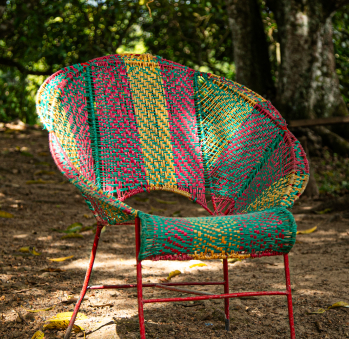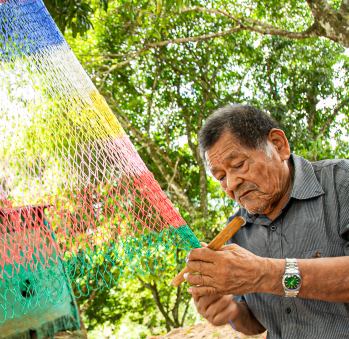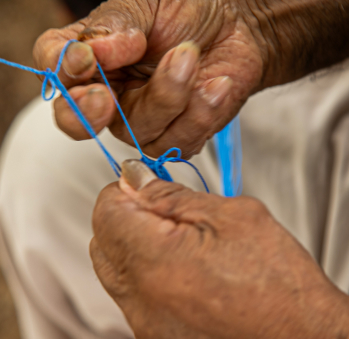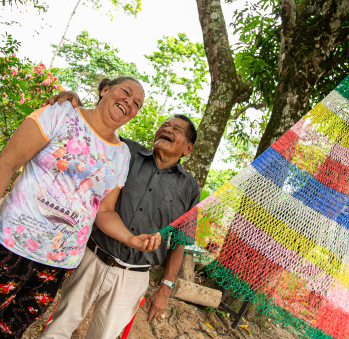Daniel Prada e Hilda Castro
Workshop: Daniel Prada Artesanías
Craft: Tejeduría
Trail: Caquetá Route
Location: El Paujil, Caquetá
SCHEDULE YOUR VISIT
Vereda Paujilita, alto de la Cruz, El Paujil, Caquetá
3203906206
The job performed by Daniel Prada and Hilda Castro demands constancy, repetition, and patience. Their story commences with Daniel, who mastered the craft before the terlenka threads he presently employs even existed. His father used to gather the mata pita agave from the scrubland and tear it using a cow’s rib bone, fashioning it into the rope he utilized for weaving chiles, chinchorro hammocks, and atarrayas. Sara Moreno and Ramón Prada raised their son, Daniel, steeped in the fishing net weaving traditions of Tolima, their place of origin. He would later encounter Hilda in Caquetá, forming both a working partnership and a family.
At the age of ten, Daniel’s father passed away. Since then, he has been well-versed in hard work. Being a proficient fisherman, he began by selling fish and the fishing gear his father had taught him to craft—chiles and atarrayas. He also sold the mats his mother had instructed him to make, as she used to sell them in town. Back then, mattresses were not readily available, so everyone slept on wide mats on the floor. He learned to gather palmicha, a long stemmed palm with a leaf on its tip, and the process of ripping, deveining, pounding, and sundrying it. Despite the abundance of mattresses today, people still purchase mats to rest on the floor for relief from the heat.
Only a handful of fishermen in Caquetá possess the skill to weave their own nets, and this artisan was fortunate to inherit the artisanal legacy passed down by his parents, who hailed from Ortega, Tolima. Chiles are nets with small holes ideal for catching sardines. They are woven with a single thread, utilizing knots, and approximately 30,000 knots are required for each chile. This exemplifies the necessary constancy and patience inherent in this craft, demanding unwavering dedication from its creator. To achieve its form, the weaver must increase the knots per round, known as “”sons,”” and metal weights are attached to the ends of the net for it to sink. On the other hand, atarrayas have wider holes and are suitable for catching larger fish like bocachico. They are woven with a double thread and also require attached weights on their ends. Despite variations in the size of the net’s holes, the technique remains unchanged. Over the years, Daniel has had to slow down and exercise more patience as his own eyes and hands, after long hours of work, tend to become numb. He is always mindful not to wash his hands after working, as the thermal shock can cause cramps.
The one who has learned all the intricate techniques, knots, and mat patterns is Hilda Castro, Daniel’s wife. Together for over thirty years, they have raised seven children, to which Daniel added the eight children he had prior to meeting her. Life brought them together in El Paujil, Hilda’s hometown and their current residence. Although Hilda did not inherit artisanal knowledge from her parents or elders, she has acquired it as if it were ingrained in her nature. Together, they form a cohesive team, crafting nets and hammocks using the same knots employed in chiles but without the “”sons,”” allowing the weave to extend for people to lie on it. They also produce meticulously woven bags with small knots, highly durable and popular among their clientele. However, Daniel’s specialty lies in romance. In their current home, there stands a piece of furniture exemplifying it: the chifonier, whose iron framework was sheathed in woven palmicha by Daniel—a gesture that adds sentimental value to the tale of this skilled artisan and his beloved wife, Hilda.
Craft








Artisans along the way
Artisans along the way
No puede copiar contenido de esta página



























































